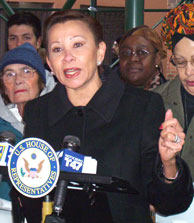A six-month study on curbside motorcoach safety by the National Transportation Safety Board shows the rapid growth of curbside carriers

poses challenges for assuring passenger safety. The study, requested by Senator Chuck Schumer and U.S. Congresswoman Nydia M.Velázquez following the March 12 bus crash in the Bronx that killed 15 and injured 18 more, highlights key safety issues related to this fast-growing segment of the transportation industry. Since March the NTSB has initiated investigations into two curbside bus crashes and has been assessing safety issues in three others. These five accidents resulted in 22 fatalities and 159 injuries.
Key study findings include:
- In general, motorcoach travel is safe. However, curbside carriers with ten or fewer buses AND carriers who have been in business for ten years or less, have higher accident rates and higher roadside inspection violation rates.
- The fatal accident rate for curbside carriers from January 2005 to March 2011 was seven times that of conventional bus operations: 1.4 fatal accidents per 100 vehicles for curbside carriers compared with 0.2 fatal accidents per 100 vehicles for conventional scheduled carriers.
- The exclusion of buses from routine enroute inspections – especially of curbside carriers that don’t operate from terminals – reduces opportunities to discover safety violations.
- The FMCSA is overburdened. For example, 878 FMCSA and state personnel are responsible for compliance reviews for more than 765,000 U.S. motor carriers, a ratio of 1.15 investigators per 1,000 motor carriers.
- Bus driver fatigue, a contributing factor in many accidents, is a continuing safety concern.
- There is a lack of transparency in ticket sales. More than conventional carriers, curbside operators use online bus brokers. FMCSA has no authority to regulate these brokers.
This report is the first comprehensive evaluation of the motorcoach industry, with an emphasis on what are commonly known as curbside carriers. Curbside motorcoach operations consist of scheduled trips that begin or end at locations other than traditional bus terminals; most of these operations pick up or discharge passengers at one or more curbside locations. The study analyzed the Federal Motor Carrier Safety Administration’s (FMCSA) data and conducted field work, which included interviews, focus groups, and observations of compliance reviews and inspections.
Of the 4,172 active interstate motorcoach carriers operating in the United States, 71 were identified as scheduled motorcoach carriers providing curbside service. Although accidents among all types of interstate motorcoach carriers (including those applying the curbside business model) are infrequent, curbside carriers have higher fatal accident and death rates and higher out-of-service rates resulting from driver violations (specifically, fatigued driving and driver fitness violations) compared with conventional carriers. Curbside carriers also have higher driver fitness violation rates and out-of-service rates, and they are overrepresented in driver logbook violations. The safety record of individual curbside carriers varies, with some carriers having very good safety records and others having worse safety records.

“It’s abundantly clear that the oversight of this industry has not kept pace with its growth and the consequences have been deadly,” said Senator Schumer. “The NTSB report is a wake-up call that we need a more rigorous regulatory regime and it provides a blueprint for how to fill the gaps.”
“When travelers board a bus, they should feel safe, whether the trip starts in a terminal or at a Chinatown sidewalk,” said Rep. Velázquez (D-NY). “The NTSB study has revealed important information about curbside motorcoach travel and, in the coming weeks, we’ll need to continue working to improve the safety regulations that govern this growing industry.”
